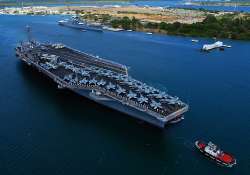Despite Iran's Threat US Vows To Keep Warships In Gulf
Washington, Jan 4: The US on Tuesday vowed to keep American warships deployed in the Persian Gulf, amid Iranian threats to take action if Washington moves its aircraft carrier into the region.Underlining its commitment to

Washington, Jan 4: The US on Tuesday vowed to keep American warships deployed in the Persian Gulf, amid Iranian threats to take action if Washington moves its aircraft carrier into the region.
Underlining its commitment to protect maritime freedom in the Persian Gulf region, the Pentagon ruled out any change in its ship deployment schedule in the key region.
“The deployment of US military assets in the Persian Gulf region will continue as it has for decades,” Pentagon Press Secretary George Little said.
“These are regularly scheduled movements in accordance with our longstanding commitments to the security and stability of the region and in support of ongoing operations,” he underlined.
The Pentagon's statement came hours after the Iranian Army chief Ataollah Salehi warned the US not to move its aircraft carrier back in the region, noting that it will take action if it did so.
“Iran will not repeat its warning.... the enemy's carrier has been moved to the Sea of Oman because of our drill. I recommend and emphasize to the American carrier not to return to the Persian Gulf,” he underlined.
The aircraft carrier Salehi was referring to was the USS John C Stennis, one of the US navy's biggest warships.
“I advise, recommend and warn them over the return of this carrier to the Persian Gulf because we are not in the habit of warning more than once,” Saleh said in a statement.
Pledging to keep American warships deployed in Persian Gulf, the Pentagon spokesman said these carrier strike group deployments are necessary to maintain the continuity and operational support to ongoing missions in the US Central Command area of responsibility.
“The US Navy operates under international maritime conventions to maintain a constant state of high vigilance in order to ensure the continued, safe flow of maritime traffic in waterways critical to global commerce,” Little said.
“Our transits of the Strait of Hormuz continue to be in compliance with international law, which guarantees our vessels the right of transit passage,” he noted.
The top Pentagon official underlined that the US was “committed to protecting maritime freedoms that are the basis for global prosperity”, adding “this is one of the main reasons our military forces operate in the region”.
The defiant Iranian threat to the US came just after Tehran ended 10 days of naval manoeuvres at the entrance to the Gulf to show it's capability to shut down the strategic oil shipping channel in the Strait of Hormuz if it felt threatened.
Iran's military on Tuesday warned one of the US navy's biggest aircraft carriers to keep away from the Gulf, in an escalating showdown over Tehran's nuclear drive that could pitch into armed confrontation.
“We advise and insist that this warship not return to its former base in the Persian Gulf,” said Brigadier General Ataollah Salehi, Iran's armed forces chief.
“We don't have the intention of repeating our warning, and we warn only once,” he was quoted as saying by the armed forces' official website.
In the climax of the war games yesterday, Iran test-fired three missiles—including a new cruise missile—designed to sink warships.
The aircraft carrier Salehi was referring to was the USS John C Stennis, one of the US navy's biggest warships.
The massive, nuclear-powered vessel transports 90 fighter jets and helicopters and is usually escorted by around five destroyers.
It is close to finishing its seven-month deployment at sea.
The carrier last week passed through the Strait of Hormuz heading east across the Gulf of Oman and through the zone where the Iranian navy was holding its manoeuvres.
The US Defence Department called its passage “routine”.
The potential for Iran-US conflict sent a shiver through oil markets Tuesday, helping oil prices jump more than a dollar a barrel.
There was no sign of a let-up in the tensions.